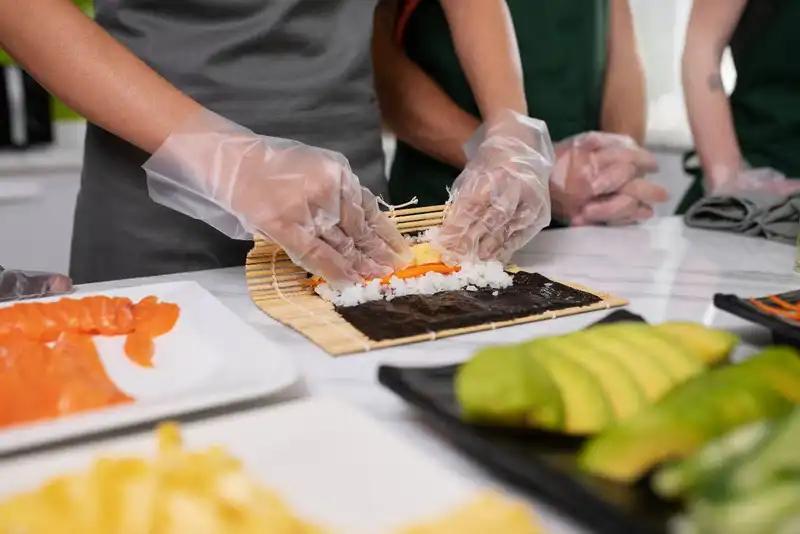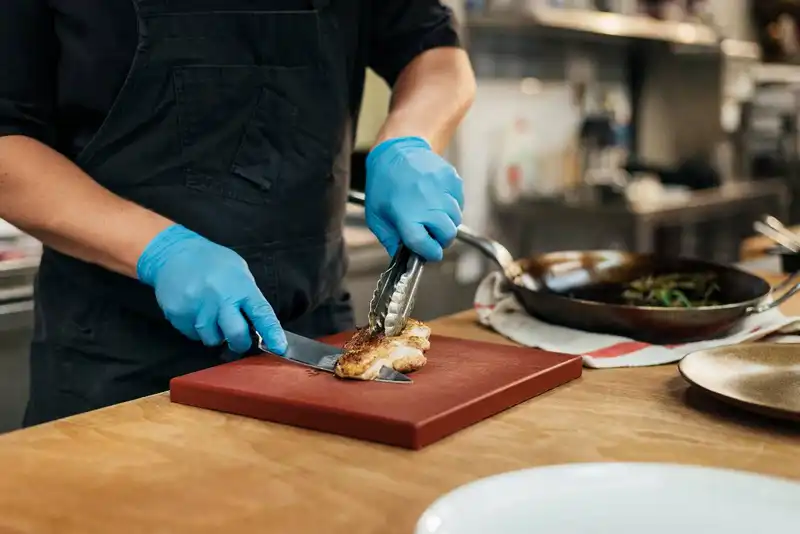What does CCP mean in food handling?
CCP stands for Critical Control Point. It's a specific step in the food handling process where control can be applied to prevent, eliminate, or reduce a food safety hazard - such as cooking, cooling, or storing food at safe temperatures.
Essential CCP Food Handling Procedures Every Restaurant Must Follow
Overview
Every restaurant, no matter its size or style, depends on one crucial factor - keeping food safe for customers. Critical Control Points (CCPs) are the specific steps in food preparation where mistakes can lead to contamination or food-borne illness. Managing these points properly isn't just about passing inspections - it's about protecting your guests, your staff, and your business reputation.
According to the CDC, Around 60% of all food-borne illness outbreaks are linked to restaurant and foodservice settings. This makes it essential for every food operator to understand CCP food handling. if you're cooking, cooling, or storing food, each stage requires close attention to time, temperature, and cleanliness.
Understanding CCPs and Their Place in HACCP

To master CCP food handling, it's important to first understand what Critical Control Points (CCPs) are and how they fit into the larger HACCP framework. HACCP - which stands for Hazard Analysis and Critical Control Points - is a globally recognized food safety management system designed to identify, prevent, and control potential hazards throughout the food production process.
A Critical Control Point is any stage in your food preparation process where control can be applied to prevent or eliminate a food safety hazard, or reduce it to an acceptable level. Common CCPs in restaurant operations include cooking, cooling, reheating, and cold storage. For example, cooking chicken to a minimum internal temperature of 165F (74C) ensures harmful bacteria like Salmonella are destroyed - that's a CCP in action.
CCPs are identified only after conducting a hazard analysis, the first step in developing a HACCP plan. During this process, restaurant managers examine every step of food handling - from receiving shipments to serving guests - and determine where contamination could occur. Once these risks are known, CCPs are established as the control points that must always stay within safe limits.
The goal of CCP monitoring isn't just regulatory compliance - it's consistency. By following HACCP principles, restaurants ensure that food safety isn't left to chance or guesswork. Every critical step is measurable, verifiable, and documented. This structured approach creates accountability among team members, reduces waste, and keeps food-borne illness risks to a minimum.
Elevate Food Safety, Simplify Compliance!
Experience Seamless Food Safety with Altametrics!
Identifying CCPs in Your Restaurant Operations
Every restaurant menu and process is different, which means your Critical Control Points (CCPs) will be unique to your operation. Identifying CCPs starts with mapping out your entire food handling process - from the moment ingredients arrive to when the meal reaches the customer's plate. At each stage, ask a simple question - "Could this step allow a hazard to occur, and can I control it here?"
To begin, conduct a hazard analysis by listing all potential risks associated with your ingredients and preparation methods. These risks typically fall into three categories -
1. Biological hazards - such as bacteria, viruses, and parasites (e.g., Salmonella, Listeria, Norovirus).
2. Chemical hazards - like cleaning agent residues, food allergens, or pesticides.
3. Physical hazards - including foreign objects like glass, plastic, or metal fragments.
Once you've identified hazards, focus on where control is critical. For instance, receiving and storage are CCPs when handling perishable goods - food must be kept below 41F (5C) to prevent bacterial growth. Cooking is another common CCP, ensuring internal temperatures are high enough to destroy pathogens. Cooling cooked food quickly, within two hours from 135F to 70F and within four hours to 41F, is another crucial CCP that prevents bacteria from multiplying.
Use a process flow chart to visualize these steps and pinpoint critical areas. Engage your kitchen staff during this process - they know the daily routines best and can help identify real risks often missed in management reviews.
By identifying your restaurant's CCPs clearly, you create a foundation for a food safety system that's both preventive and practical. The goal isn't to complicate operations but to ensure each critical step is predictable, measurable, and safe - no matter who's on shift.
Setting Critical Limits for Each CCP
Once you've identified your Critical Control Points (CCPs), the next essential step is to set critical limits - the exact, measurable boundaries that define safe versus unsafe conditions. These limits ensure that food stays within acceptable safety ranges, preventing the growth of harmful microorganisms or the introduction of contaminants.
A critical limit is a specific value such as time, temperature, pH, or humidity that must be met at each CCP. For example, raw poultry must reach an internal temperature of 165F (74C) for at least 15 seconds to destroy pathogens like Salmonella. Cold storage must maintain temperatures at or below 41F (5C) to prevent bacterial growth. Cooked food must be cooled from 135F to 70F within two hours, then to 41F within four hours limits recommended by the FDA Food Code.
When setting these limits, use credible reference sources such as the U.S. Food and Drug Administration (FDA), U.S. Department of Agriculture (USDA), or local health departments. Never rely on assumptions or what seems safe. Precision is what separates effective food safety systems from inconsistent ones.
It's also important to ensure measurement accuracy. Use calibrated thermometers, timers, and pH meters to verify that your CCPs meet required limits. Even a few degrees of error can mean the difference between safe and unsafe food.
Finally, make sure every employee understands what each limit means and why it matters. Post visual charts in prep areas, label storage units with acceptable temperature ranges, and review them during staff meetings. Setting and communicating clear critical limits transforms food safety from a checklist into a culture of precision and responsibility.
Monitoring CCPs

Establishing CCPs and critical limits is only effective if those points are monitored consistently. Monitoring is the process of observing, measuring, and recording whether each critical limit is being met in real time. It's the backbone of CCP food handling - ensuring that food safety doesn't depend on luck, but on discipline and data.
Every CCP in your restaurant must have a specific monitoring procedure. For instance, checking the internal temperature of cooked chicken ensures it reaches 165F before serving. Recording cooler temperatures at least twice per shift confirms food remains below 41F. Monitoring must be both accurate and frequent enough to catch issues before they become problems.
There are two main types of monitoring methods -
1. Continuous monitoring, such as using digital sensors or automated systems that track temperature 24/7.
2. Non-continuous (manual) monitoring, like using a thermometer or time log at regular intervals.
Each has its place depending on your operation's size and budget. Small restaurants may rely on manual logs, while larger operations can benefit from connected monitoring devices that alert staff when limits are breached.
Equally important is assigning responsibility. Designate trained staff to perform and document each monitoring activity. Records should include date, time, temperature readings, initials, and corrective actions if necessary. Keeping this information in a centralized logbook or digital system ensures accountability and simplifies inspection readiness.
Consistent monitoring not only protects food safety but also strengthens staff awareness. When employees regularly record data and understand its purpose, they develop habits that prevent contamination and ensure every plate leaving the kitchen is safe and compliant.
Create, Implement, and Execute Multiple Daily Checklists
Streamline Your Operations with Altametrics
Taking Corrective Actions When a CCP Fails
Even the best food safety systems can experience occasional breakdowns. When a Critical Control Point (CCP) fails to meet its critical limit, quick and structured action is essential to protect customers and maintain compliance. Corrective actions ensure that unsafe food is identified, controlled, and prevented from reentering service. Here's how to manage the process effectively -
1. Identify and Isolate the Problem
As soon as a deviation is detected, remove the affected food from service immediately. For instance, if cooked chicken is found holding at 120F instead of 135F, it should be reheated to at least 165F before serving. If it cannot be safely corrected, discard it - never rework or reuse food that has fallen outside safety limits.
2. Determine the Root Cause
Investigate why the CCP failed. Was the equipment malfunctioning? Was there a missed temperature check or uncalibrated thermometer? Identifying the source of failure helps prevent the same issue from recurring and strengthens your HACCP program.
3. Take and Document Corrective Actions
Record every detail- the issue identified, the action taken, who handled it, and the result. For example, note the temperature deviation, reheating step, and final verification reading. This documentation serves as proof of compliance during inspections and audits.
4. Train and Reinforce Staff Responsibilities
Employees should know exactly what to do when a CCP fails. Conduct refresher training, review real-life examples, and assign clear accountability. Reinforcing procedures helps staff respond quickly and confidently when problems arise.
Corrective actions are opportunities to learn and improve. When handled systematically, they build a safer kitchen culture and ensure your food consistently meets HACCP standards.
Verifying and Documenting CCP Procedures
Verification and documentation are what transform your food safety system from good intentions into solid proof of compliance. After all, HACCP isn't only about following procedures - it's about showing that those procedures work. Verification confirms that monitoring, corrective actions, and record-keeping are being done correctly, while documentation creates a paper trail that demonstrates consistency and accountability.
Verification ensures that CCPs are being controlled as intended. This can include several activities
1. Reviewing monitoring logs to ensure temperature readings and corrective actions were properly recorded.
2. Calibrating thermometers and sensors regularly to verify accuracy.
3. Conducting internal audits to confirm employees are performing safety checks correctly.
4. Inspecting records for missing data or incomplete entries.
These verification steps should be scheduled routinely - daily, weekly, or monthly depending on the task. For instance, managers might check temperature logs daily but verify equipment calibration monthly. The goal is to catch small inconsistencies before they become major compliance problems.
Documentation is equally critical. Every action related to CCPs - from monitoring and calibration to corrective measures - must be recorded and stored securely. Digital systems are especially useful here, allowing you to log data in real time, set alerts, and access records instantly during inspections.
Accurate documentation does more than satisfy inspectors - it protects your restaurant. If a foodborne illness claim arises, detailed CCP records can show that your team followed proper procedures. Ultimately, verification and documentation are the foundation of accountability. They turn food safety from a one-time task into an ongoing, trackable process that builds trust and ensures compliance.
Building a CCP-Focused Food Safety Culture
No matter how strong your procedures are, true food safety depends on people - their awareness, consistency, and care. Building a CCP-focused food safety culture means creating an environment where every employee understands the "why" behind each step and takes personal responsibility for keeping food safe. It's about turning compliance into habit and habit into pride.
Start by making training ongoing and engaging, not a one-time event. Use visual aids, real kitchen examples, and short refreshers during pre-shift meetings. For instance, remind cooks about correct holding temperatures or walk staff through what to do if a thermometer reading falls outside a limit. When training connects directly to daily tasks, it sticks.
Second, empower your team to act. Encourage employees to speak up if they see something unsafe - whether it's improper storage or a missed temperature check. Make sure they know management supports them in taking corrective actions immediately. Recognition goes a long way here- when staff feel trusted and appreciated for doing things right, they're more likely to stay consistent.
Third, lead by example. Managers should follow the same rules they expect from their team, from handwashing to logging temperatures. Visible commitment from leadership reinforces that food safety is everyone's job, not just a box to check for inspectors.
Finally, use data to drive improvement. Review CCP records, look for patterns, and adjust training or processes where needed. Continuous learning strengthens your system and builds long-term trust with customers and regulators alike.



























































































































































































































































